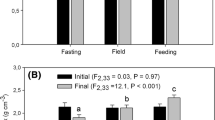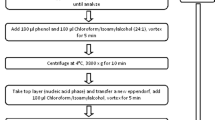Abstract
Effects of food availability and season on the free amino acid (FAA) and total protein content of the copepod Calanus finmarchicus females were investigated in two mesocosm experiments on the Norwegian west coast in spring and autumn. Starved C. finmarchicus females showed no change in total FAA content, but the FAA pool composition changed drastically. During the first 10 days of starvation the protein content showed a moderate decline (<2 μg ind−1); however, during the following 21 days the total content was drastically reduced, from 63 to 9 μg ind−1. This supports the notion of a sequential catabolism of endogenous nutrients during starvation. In females at high food concentrations, the body protein content increased during spring, but decreased during autumn. The FAA pool composition of females differed between spring and autumn in 14 of the 18 FAA investigated. Reduced body protein content and increased proportion of essential free amino acid were observed during starvation. Similar changes were observed in females sampled at the end of the mesocosm experiments in the autumn. The results suggest that mature C. finmarchicus females are in a negative protein balance during autumn, despite high food concentrations, contributing to a lower fitness than in females maturing during the spring.




Similar content being viewed by others
References
Aragão C, Conceição LEC, Fyhn HJ, Dinis MT (2001) Amino acid profiles of sea bream (Sparus aurata) and sole (Solea senegalesisi) during first feeding: are currently used diets imbalanced in amino acids? In: Hendry CI, Van Stappen G, Wille M, Sorgeloos P (eds) Special publication number 30. European Aquaculture Society, Oostende
Båmstedt U (2000) Life cycle, seasonal vertical distribution and feeding of Calanus finmarchicus in Skagerak coastal water. Mar Biol 137:279–289
Båmstedt U, Holt MR (1978) Experimental studies on the deep-water pelagic community of Korsfjorden, western Norway. Sarsia 63:225–236
Båmstedt U, Nejstgaard JC, Solberg PT (1999) Utilisation of small-sized food algae by Calanus finmarchicus (Copepoda, Calanoida) and the significance of feeding history. Sarsia 84:19–38
Campbell RG, Runge JA, Durbin EG (2001) Evidence for food limitation of Calanus finmarchicus production rates on the southern flank of Georges Bank during April 1997. Deep-Sea Res II 48:531–549
Cowey CB, Corner EDS (1963) On the nutrition and metabolism of zooplankton. II. The relationship between the marine copepod Calanus helgolandicus and particulate material in Plymouth Sea water, in terms of amino acid composition. J Mar Biol Assoc UK 43:495–511
Dalla Via GJ (1989) The effect of salinity on free amino acids in the prawn Palaemon elegans (Rathke). Arch Hydrobiol 115:125–135
Egge JK (1993) Nutrient control of phytoplankton growth: effects of macronutrient composition (N, P, Si) on species succession. Ph.D. thesis, University of Bergen
Egge JK, Aksnes DL (1992) Silicate as regulating nutrient in phytoplankton competition. Mar Ecol Prog Ser 83:281–289
Egge JK, Jacobsen A (1997) Influence of silicate on particulate carbon production in phytoplankton. Mar Ecol Prog Ser 147:219–230
Fraser AJ, Sargent JR, Gamble JC (1989) Lipid class and fatty acid composition of Calanus finmarchicus (Gunnerus), Pseudocalanus sp. and Temora longicornis Muller from a nutrient enriched seawater enclosure. J Exp Mar Biol Ecol 130:81–92
Frost BW (1974) Calanus marshallae, a new species of calanoid copepod closely allied to the sibling species C. finmarchicus and C. glacialis. Mar Biol 26:77–79
Fyhn HJ (1976) Holeuryhalinity and its mechanisms in a cirriped crustacean, Balanus improvisus. Comp Biochem Physiol 53A:19–30
Fyhn HJ, Finn RN, Helland S, Rønnestad I, Lømsland ER (1993) Nutritional value of phyto- and zooplankton as live food for marine fish larvae. In: Reinertsen H, Jørgensen L, Tvinnereim K (eds) Proceedings of the first international conference on fish farming technology. Balkema, Rotterdam, pp 121–126
Goolish EM, Burton R (1988) Exposure to fluctuating salinity enhances free amino acid accumulation in Tigriopus californicus (Copepoda). J Comp Physiol B 158:99–105
Guisande C, Maneiro I, Riveiro I (1999) Homeostasis in the essential amino acid composition of the marine copepod Euterpina acutifrons. Limnol Oceanogr 44:691–696
Guisande C, Riveiro I, Maneiro I (2000) Comparisons among the amino acid composition of females, eggs and food to determine the relative importance of food quantity and food quality to copepod reproduction. Mar Ecol Prog Ser 202:135–142
Guillaume J (1997) Protein and amino acids. In: D´Abramo LR, Conklin DE, Akiyama DM (eds) Crustacean nutrition. Advances in world aquaculture, vol 6. World Aquaculture Society, Louisiana State University, Baton Rouge
Hansen PJ, Bjørnsen PK, Hansen BW (1997) Zooplankton grazing and growth: scaling within the 2–2,000-μm body size range. Limnol Oceanogr 42:687–704
Helland S, Triantaphyllidis GV, Fyhn HJ, Evjen MS, Lavens P, Sorgeloos P (2000) Modulation of the free amino acid pool and protein content in populations of the brine shrimp Artemia spp. Mar Biol 137:1005–1016
Helland S, Nejstgaard JC, Humlen R, Fyhn HJ, Båmstedt U (2003a) Effects of season and maternal food on Calanus finmarchicus reproduction, with emphasis on free amino acids. Mar Biol 142:1141–1151
Helland S, Terjesen BF, Berg L (2003b) Free amino acid and protein content in the planktonic copepod Temora longicornis compared to Artemia franciscana. Aquaculture 215:213–228
Hirche H-J (1996a) The reproductive biology of the marine copepod, Calanus finmarchicus—a review. Ophelia 44:111–128
Hirche H-J (1996b) Diapause in the marine copepod, Calanus finmarchicus—a review. Ophelia 44:129–143
Hygum BH, Rey C, Hansen BW, Tande K (2000) Importance of food quality to structural growth rate and neutral lipid reserves accumulated in Calanus finmarchicus. Mar Biol 136:1057–1073
Ikeda A, Kanno Y, Ozaki K, Shinada A (2001) Metabolic rates of epipelagic marine copepods as a function of body mass and temperature. Mar Biol 139:587–596
Jaschnov WA (1972) On the systematic status of Calanus glacialis, Calanus finmarchicus and Calanus helgolandicus. Crustaceana 22:279–284
Jeffries HP (1969) Seasonal composition of temperate plankton communities: free amino acids. Limnol Oceanogr 14:41–52
Jeffries HP, Alzara L (1970) Dominance-diversity relationships of the free amino acids in coastal zooplankton. Comp Biochem Physiol 37:215–223
Kattner, G, Krause M (1987) Changes in lipids during the development of Calanus finmarchicus from copepodid I to adult. Mar Biol 96:511–518
Klein Breteler WCM, Schogt N, Gonzales SR (1990) On the role of food quality in grazing and development of life stages, and genetic change of body size during cultivation of pelagic copepods. J Exp Mar Biol Ecol 135:177–189
Klein Breteler WCM, Schogt N, Baas M, Schouten S, Kraay GW (1999) Trophic upgrading of food quality by protozoans enhancing copepod growth: role of essential lipids. Mar Biol 135:191–198
Kleppel GS (1993) On the diets of calanoid copepods. Mar Ecol Prog Ser 99:183–195
Lee RF (1974) Lipid composition of the copepod Calanus hyperboreus from the Arctic Ocean. Changes with depth and season. Mar Biol 26:313–318
Lee RF, Neventzel JC, Paffenhöfer GA, Benson AA (1970) The metabolism of wax esters and other lipids by the marine copepod Calanus helgolandicus. J Lipid Res 11:237–240
Levinsen H, Turner JT, Nielsen TG, Hansen BW (2000) On the trophic coupling between protists and copepods in arctic marine ecosystems. Mar Ecol Prog Ser 204:65–77
Lowry OH, Rosebrough NJ, Lewis Farr A, Randall RJ (1951) Protein measurement with the folin phenol reagent. J Biol Chem 193:265–275
Marshall SM, Orr AP (1955) The biology of a marine copepod Calanus finmarchicus Gunnerus. Oliver and Boyd, Edinburgh
Mayzaud P (1976) Respiration and nitrogen excretion of zooplankton. IV. The influence of starvation on the metabolism and the biochemical composition of some species. Mar Biol 37:47–58
Menden-Deuer S, Lessard EJ (2000) Carbon to volume relationships for dinoflagellates, diatoms, and other protist plankton. Limnol Oceanogr 45:569–579
Mommsen TP (2001) Paradigms of growth in fish. Comp Biochem Physiol 129:207–219
Nejstgaard JC, Witte HJ, Wal P van der, Jacobsen A (1994) Copepod grazing during a mesocosm study of an Emiliania huxley (Prymnesiophyceae) bloom. Sarsia 79:369–377
Nejstgaard JC, Gismervik I, Solberg PT (1997) Feeding and reproduction by Calanus finmachicus, and microzooplankton grazing during mesocosm blooms of diatoms and the coccolitophore Emiliania huxleyi. Mar Ecol Prog Ser 147:197–217
Nejstgaard J, Naustvoll L-J, Sazhin A (2001a) Correcting for underestimation of microzooplankton grazing in bottle incubation experiments with mesozooplankton. Mar Ecol Prog Ser 221:59–75
Nejstgaard J, Hygym B, Naustvoll L-J, Båmstedt U (2001b) Zooplankton growth, diet and reproductive success compared in simultaneous diatom- and flagellate- microzooplankton-dominated plankton blooms. Mar Ecol Prog Ser 221:77–91
Naess T, Germain-Henry M, Naas KE (1995) First feeding of Atlantic halibut (Hippoglossus hippoglossus) using different combinations of Artemia and wild zooplankton. Aquaculture 130:235–250
Ohman MD, Runge JA (1994) Sustained fecundity when phytoplankton resources are in short supply: omnivory by Calanus finmarchicus in the Gulf of St.Lawrence. Limnol Oceanogr 39:21–36
Østvedt O-J (1955) Zooplankton investigations from Weather Ship M in the Norwegian Sea, 1948–49. Hvalråd Skr 40:1–93
Parsons TR, Maita Y, Lalli CM (1984) A manual of chemical and biological methods for seawater analysis. Pergamon Press, Oxford
Pasternak A, Arashkevich E, Tande K, Falkenhaug T (2001) Seasonal changes in feeding, gonad development and lipid stores in Calanus finmarchicus and C. hyperboreus from Malangen, northern Norway. Mar Biol 138:1141–1152
Putt M, Stoecker DK (1989) An experimentally determined carbon: volume ratio for marine "oligotrichous" ciliates from estuarine and coastal waters. Limnol Oceanogr 34:1097–1103
Rønnestad I, Finn NR, Groot EP, Fyhn HJ (1992) Utilization of free amino acids related to energy metabolism of developing eggs and larvae of lemon sole Microstomus kitt reared in the laboratory. Mar Ecol Prog Ser 88:195–205
Rousseau V, Mathot S, Lancelot C (1990) Calculating carbon biomass of Phaeocystis sp. from microscopic observations. Mar Biol 107:305–314
Sargent JR, Lee RF, Neventzel JC (1976) Marine waxes. In: PE Kolattukdy (ed) Chemistry and biochemistry of natural waxes. Elsevier, Amsterdam, pp 50–91
Schoffeniels E (1976) Adaptations with respect to salinity. Biochem Soc Symp 41:179–204
Svensen C, Tande K (1999) Sex change and female dimorphism in Calanus finmarchicus. Mar Ecol Prog Ser 176:93–102
Svensen C, Egge J, Stiansen J (2001) Can silicate and turbulence regulate the vertical flux of biogenic matter? A mesocosm study. Mar Ecol Prog Ser 217:67–80
Svensen C, Nejstgaard JC, Egge JK, Wassmann P (2002) Pulsing versus constant supply of nutrients (N, P and Si): effect on phytoplankton community, mesozooplankton grazing and vertical flux of biogenic matter. Sci Mar 66:189–203
Tande KS (1991) Calanus in north Norwegian fjords and in the Barents Sea. Polar Res 10:389–407
Torres JJ, Aarset AV, Donnelly J, Hopkins TL, Lancraft TM, Ainley DG (1994) Metabolism of Antarctic micronektonic Crustacea as a function of depth of occurrence and season. Mar Ecol Prog Ser 113:207–219
Tulli F, Tibaldi E (1997) Changes in amino acids and essential fatty acids during early larval rearing of dentex. Aquaculture 5:229–236
Wiborg KF (1955) Investigations on zooplankton in coastal and offshore waters of western and northwestern Norway with special reference to the copepods. Fisk Dir Skr Ser Havunders 11:1–246
Williams P le B, Egge JK (1998) The management and behaviour of the mesocosm. Estuar Coast Shelf Sci 46:3–14
Yancey PH, Clark ME, Hand SC, Bowlus RD, Somero GN (1982) Living with water stress: evolution of osmolyte systems. Science 217:1214–1222
Zar JH (1996) Biostatistical analysis, 3rd edn. Prentice-Hall, London
Acknowledgements
We acknowledge the experimental and field assistance of Rikard Humlen and the analytical assistance of Maria Sula Evjen, Monica Martinussen and Aud Larsen. This work was a part of the MARICULT project NAPP and was supported by grants from the Research Council of Norway. These experiments comply with the current animal experimental laws of Norway, the country in which the present work was conducted.
Author information
Authors and Affiliations
Corresponding author
Additional information
Communicated by L. Hagerman, Helsingør
Rights and permissions
About this article
Cite this article
Helland, S., Nejstgaard, J.C., Fyhn, H.J. et al. Effects of starvation, season, and diet on the free amino acid and protein content of Calanus finmarchicus females. Marine Biology 143, 297–306 (2003). https://doi.org/10.1007/s00227-003-1092-x
Received:
Accepted:
Published:
Issue Date:
DOI: https://doi.org/10.1007/s00227-003-1092-x




